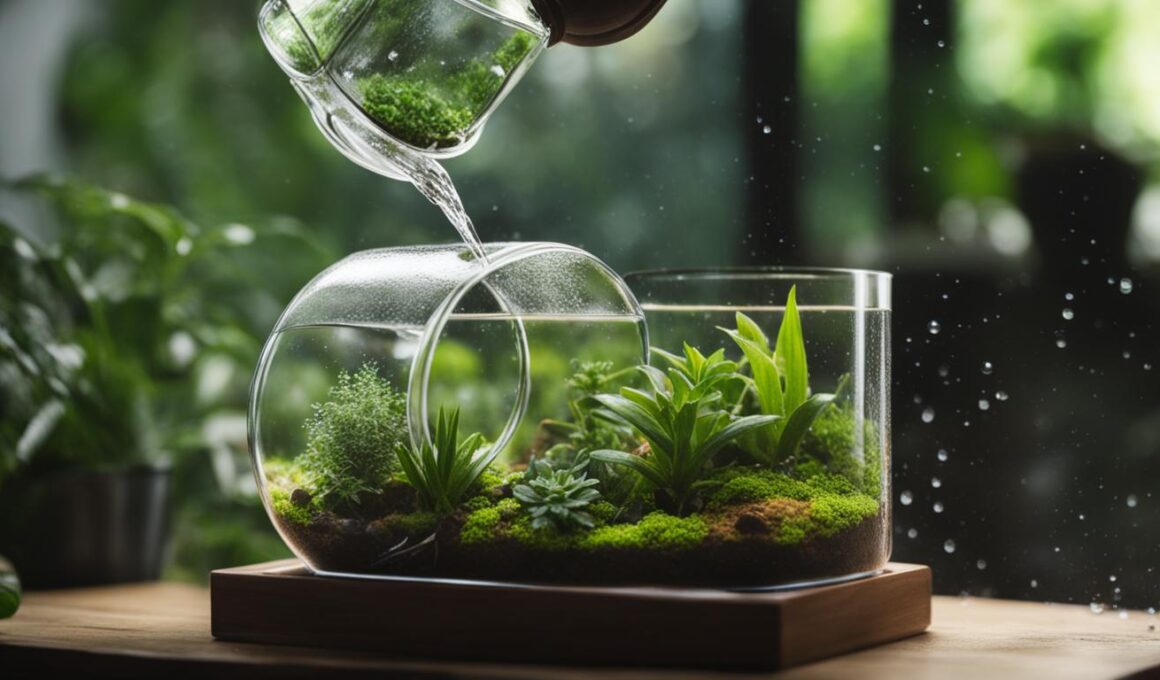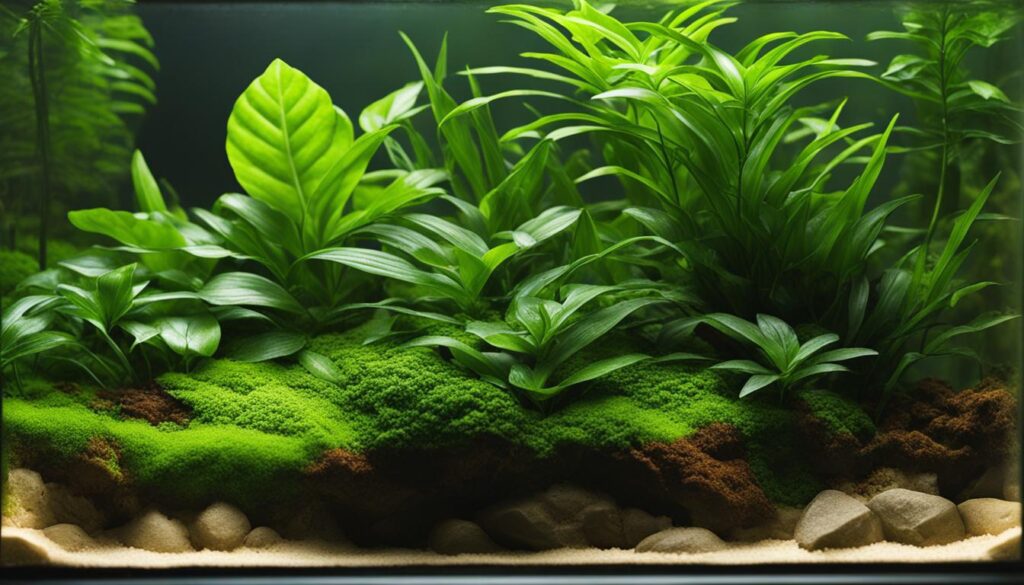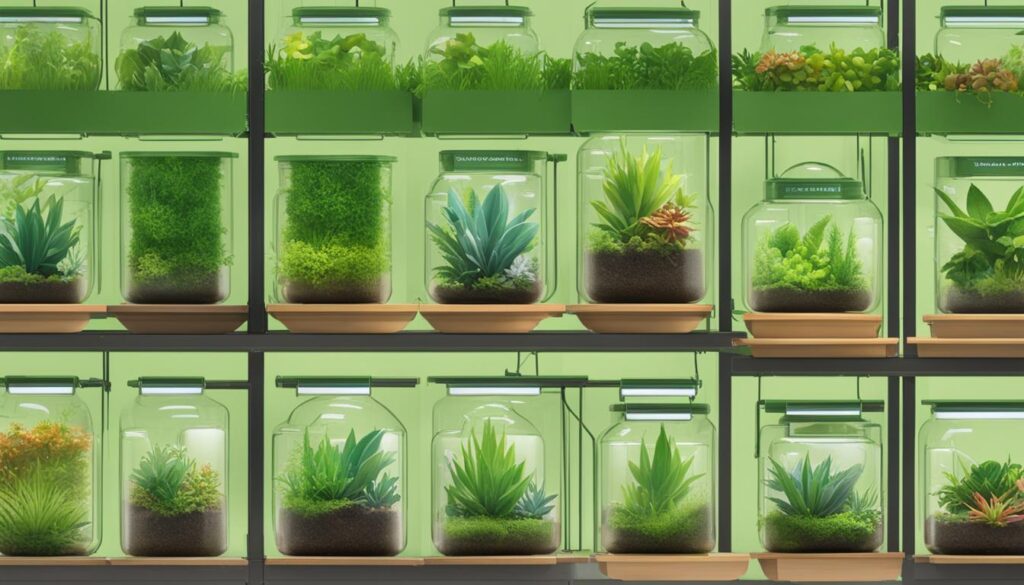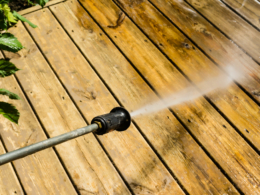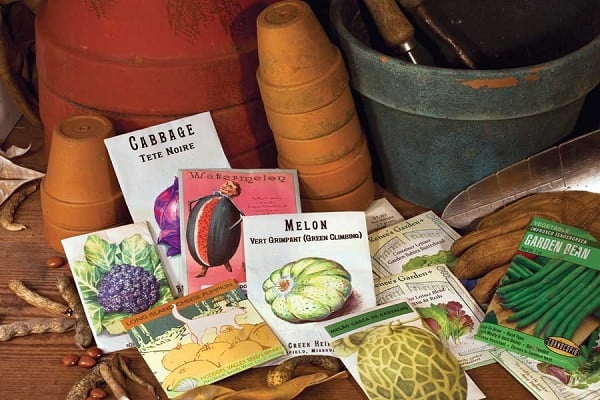Discover how terrarium watering differs from the needs of regular houseplants, and learn the art of maintaining the perfect moisture balance within your sealed or open terrarium. By understanding the unique environment of a terrarium, you can gauge the appropriate watering quantity based on container size, plant type, and enclosing conditions. Recognize the indicators for adding water, and establish a watering regimen that aligns with your terrarium’s ecosystem cycle, keeping it lush and thriving.
Key Takeaways
- Terrarium watering requires a different approach than regular houseplants.
- Maintaining the right moisture balance is crucial for a healthy terrarium ecosystem.
- Container size, plant type, and enclosure conditions affect watering needs.
- Watch for signs such as condensation and soil moisture to determine when to water your terrarium.
- Create a consistent and appropriate watering schedule based on your terrarium’s unique properties.
Understanding Terrarium Watering Basics
Terrariums create a unique environment, where watering is not only about quantity, but also technique and understanding the ecosystem. Unlike potted houseplants, terrariums lack drainage, meaning water must be added carefully to avoid overwatering. Finding the correct amount of water to provide your terrarium is key to maintaining a healthy balance.
The Distinctive Needs of Terrarium Plants Compared to Houseplants
Terrarium plants differ significantly from houseplants, requiring a unique watering approach due to the enclosed environment that can recycle water, preventing excess from draining away as in houseplants. A balance of moisture is crucial, as overwatering can lead to root rot, whereas under-watering can cause plant stress and wilt.
Identifying the Right Amount of Water for Your Ecosystem
Determining the right amount of water relies on several variables such as terrarium size, type of enclosure, volume of soil, and the number of plants contained. Use tactile feedback to gauge the moisture level—soil should be moist to the touch but not soggy. The visual presence of fog or condensation inside the terrarium can indicate a successfully functioning water cycle. Here are some general guidelines to help you estimate the right amount of water for your terrarium:
| Terrarium Size | Estimated Water Amount |
|---|---|
| Quart-sized | ¼ cup |
| Half-gallon | ½ cup |
| Gallon-sized or larger | 1 cup |
Keep in mind that these are just general recommendations and the actual amount of water may vary depending on the specific needs of your terrarium ecosystem.
To maintain the perfect moisture balance within your terrarium, keep these factors in mind as you establish your watering regimen, and promotes a thriving ecosystem for your plants to grow and flourish.
The Risk of Overwatering and How to Avoid Root Rot
Overwatering your terrarium poses a significant threat to the health of your plants. It can deprive them of oxygen and lead to fungal infections like root rot. This can cause the roots to become mushy and brown, ultimately causing the plant to wilt. To avoid these problems, it’s essential to monitor the soil’s moisture level and prevent it from getting too damp.
- Regularly inspect the soil for moisture. Use your fingers to feel if the soil is damp, but not waterlogged. This will help you find the perfect balance between overwatering and under-watering your plants.
- Keep an eye on your terrarium’s condensation levels. While some condensation is expected and signifies a healthy water cycle, excessive condensation indicates overhydration and needs to be addressed.
- Consider the type of enclosure you have. Open terrariums might require more frequent waterings, whereas sealed terrariums could recycle their water for longer periods of time.
Root rot is a preventable problem when you take the necessary steps to maintain ideal moisture levels in your terrarium. Here are three methods to ensure optimal watering for your terrarium plants:
| Watering Method | Description | Benefits |
|---|---|---|
| Misting | Using a spray bottle, lightly mist the plants and the interior glass walls of the terrarium. | Provides a gentle, even distribution of water, and simulates natural rainfall environment for plants. |
| Bottom Watering | For open terrariums, fill a shallow tray with water and place the terrarium inside. Allow the soil to absorb water from the bottom up. | Reduces the risk of overwatering and prevents the soil from being disturbed, preserving plant roots. |
| Direct Watering | Apply water directly to the soil around the base of the plants using a small watering can or measuring cup. | Targets specific plants that may need more water than others in the terrarium and allows for precise control over the amount of water used. |
By carefully monitoring your terrarium’s watering requirements and implementing proper watering techniques, you will promote a healthy environment for your plants and prevent the risk of overwatering and root rot.
Optimal Watering Techniques for Terrariums
Effective watering techniques for terrariums involve using a spray bottle set to a ‘stream’ to moisten the interior glass walls without directly soaking the soil. Uniform coverage of glass sides ensures even distribution of moisture when water trickles down, simulating natural rainfall. The optimal watering technique includes the following steps:
- Choose a spray bottle: Select a spray bottle capable of adjusting the nozzle to a stream setting.
- Prepare the water: Fill the spray bottle with water suitable for your terrarium plants.
- Adjust the nozzle: Set the nozzle of the spray bottle to a stream setting.
- Open the terrarium: Carefully open the terrarium to access the interior.
- Target the glass walls: Focus on the interior glass walls, rotating in a complete circle to cover all sides with water.
- Close the terrarium: Securely close the terrarium to maintain the desired moisture level.
By following these steps, you can prevent over-saturation of the soil while ensuring a consistent moisture level within the terrarium.
Using the Spray Bottle Method Effectively
The spray bottle method allows you to replicate the natural rainfall experience for your terrarium plants, safeguarding them from the harmful effects of insufficient or excessive moisture. By targeting the glass walls during watering, you can distribute moisture evenly across all plants and substrates. Consistent watering using the spray bottle method can ensure a healthy and vigorous terrarium ecosystem.
The Importance of a Proper Drainage Layer
Constructing a reliable drainage layer is fundamental to terrarium health and water management, especially in containers lacking drainage holes. This layer, consisting of rocks and horticultural charcoal, should sit at the terrarium’s base, a minimum of ¼ inch high, to capture excess water and prevent root exposure to stagnant moisture.
Creating a Foundation with Rocks and Horticultural Charcoal
Establish a strong drainage layer to hold excess water and prevent soil saturation. Fill the base of your terrarium with a combination of rocks and horticultural charcoal, offering a safeguard against root rot and maintaining ideal humidity levels for terrarium plants.
Here’s how you can create a drainage layer in your terrarium:
- Start with a clean, dry, and empty terrarium.
- Add a layer of rocks to the base of the terrarium. Rocks like pea gravel, small pumice stones, or large perlite are suitable choices. Ensure a minimum thickness of 1/4-inch.
- Spread a layer of horticultural charcoal on top of the rocks. Charcoal helps in absorbing excess moisture and odors within the terrarium.
- Smooth out the surface and prepare for the next layer of soil
It is essential to maintain the drainage layer for the health of your terrarium plants. By monitoring water levels and regularly checking the drainage layer’s condition, you will ensure long-lasting success for your terrarium ecosystem.
| Component | Benefits |
|---|---|
| Rocks | Prevents soil saturation, promotes air circulation around the roots and absorbs excess water at the terrarium’s base |
| Horticultural Charcoal | Absorbs excess moisture, eliminates odors, purifies the water, and assists in maintaining optimal humidity levels |
Keep in mind that providing a proper drainage layer is just one aspect of maintaining a healthy terrarium. It is equally important to understand and implement the correct watering techniques, recognize the signs your terrarium needs water, and time your watering schedule based on enclosure type to ensure optimal terrarium health.
Troubleshooting Common Watering Issues
While maintaining proper moisture levels is crucial for a thriving terrarium, issues will inevitably arise. Knowing how to address common problems is essential for keeping plants healthy. Let’s explore typical watering issues and how you can effectively troubleshoot them.
- Overwatering leading to soggy soil
When you accidentally add too much water to your terrarium, the soil can become soggy, increasing the risk of root rot and other water-induced plant diseases. In such cases, instead of waiting for the soil to dry out naturally, you can employ a pipette to draw out the excess water. This mitigates the consequences of unintentional overwatering, allowing your plants to recuperate.
Stagnant water and high humidity in a terrarium can lead to bacterial and fungal growth, resulting in plant diseases. To prevent this, you should identify the cause of excess water and adjust your watering technique or schedule accordingly. Ensure proper drainage is in place and consider using horticultural charcoal to help absorb and regulate moisture.
- Plant wilting or yellowing
Wilting or yellowing leaves can result from both overwatering and underwatering. To determine which issue is affecting your terrarium, check the soil moisture. If it is too dry, then increase your watering frequency. Conversely, if the soil is waterlogged, reduce the amount of water added and employ a pipette to remove excess moisture.
By understanding the unique needs of your terrarium plants and staying alert to potential watering issues, you can effectively troubleshoot any problems and maintain a lush, thriving environment for your plants.
Timing Your Watering Schedule for Different Enclosures
Although terrariums serve as self-sustaining ecosystems, periodic watering is necessary, especially for specific enclosures. Watering schedules depend on various factors like enclosure type, size, and plant variety.
Identifying Water Needs Based on Enclosure Type
Enclosure style has a significant impact on the watering needs of terrariums. Generally, enclosures with tight-fitting, well-sealed lids don’t require additional water after the initial setup. Containers with loose-fitting lids, however, need more water maintenance. Let’s examine the watering requirements for different enclosure types:
| Enclosure Type | Watering Frequency |
|---|---|
| Terrarium with tight-fitting lid (cork, rubber, or glass) | No additional water needed after initial setup |
| Terrarium with a loose-fitting lid | Every three months |
Recognizing Signs that Your Terrarium Needs Water
Although understanding your terrarium type helps determine appropriate watering intervals, it’s crucial to recognize signs indicating the need for water. Routinely assessing plant health and monitoring condensation can help guide your watering schedule. Here are a few common indicators suggesting it’s time to add water:
- Substrate feels dry to the touch
- Lack of visible condensation
- Yellowing or wilting leaves
- Faded plant colors
Keep in mind that condensation is expected, especially during temperature peaks; this indicates an active water cycle in the terrarium. If you consistently observe increased condensation, consider reducing your watering frequency.
By understanding the specific demands of your terrarium enclosure and recognizing the signs of water requirements, you can maintain a healthy moisture cycle and a thriving ecosystem. Remember that moderation is key, and adopt a conservative watering approach to prevent overwatering, root rot, and other complications.
Decoding Terrarium Condensation: What’s Normal and What’s Not
Condensation in a terrarium is a natural and promising sign of a functioning water cycle, visible during the warmest parts of the day. However, continuous excessive condensation might imply overhydration. In this section, we will discuss what is considered normal condensation and the potential issues with excessive condensation. Additionally, we will provide a solution for clearing condensation without disrupting your terrarium’s moisture balance.
Typically, a healthy terrarium will exhibit some condensation during the warmest parts of the day. As the temperature increases, the water inside the terrarium evaporates and forms vapor. This vapor then condenses on the glass walls of the terrarium, creating a visible layer of moisture. If the condensation is limited to the warmest parts of the day, without pooling or consistently fogging up the enclosure, it is likely that your terrarium has a well-functioning water cycle.
However, continuous excessive condensation can be an indication of overhydration. Signs of overhydration include:
- Constantly foggy or obscured glass
- Water pooling at the bottom of the enclosure
- Mold or fungus growth
- Yellowing or wilting plant leaves
If your terrarium exhibits any of these signs, you may need to adjust your watering practices to reduce the amount of water in the system, avoiding potential issues such as root rot and fungal infections.
Should you wish to clear the condensation without disrupting your terrarium’s moisture balance, consider using a magnetic scrubber. Utilized in aquarium maintenance, magnetic scrubbers allow you to clean the interior glass walls without having to open the enclosure. Simply attach the scrubber components to opposite sides of the glass and move the external scrubber, which is connected by a strong magnet, to clean the condensation away without disturbing the terrarium environment and plants.
By understanding the difference between normal and excessive condensation, you can better gauge the health of your terrarium’s water cycle and make adjustments as needed to maintain optimal moisture levels for your plants.
:Is the watering frequency for pothos plants similar to that of terrariums?
Yes, the comprehensive pothos watering schedule can be similar for both pothos plants and terrariums. Both typically require soil that is kept consistently moist but not waterlogged. However, it’s important to monitor the specific conditions of each individual plant and adjust the watering frequency as needed.
Mastering the Art of Terrarium Watering
As a terrarium owner, understanding the distinctive watering needs and techniques for your ecosystem is essential. Terrariums differ significantly from houseplants and require a unique approach that factors in enclosure type, plant needs, and environmental conditions. With careful attention to these elements, you can ensure a thriving terrarium with a self-sustaining moisture cycle.
Start by recognizing the indicators that suggest your terrarium needs water, such as dry substrate, lack of condensation, or plant changes. Then, adjust your watering regimen accordingly. Remember, the right amount of water varies based on your terrarium’s unique conditions, so it’s vital to find the balance that works best for yours.
Effective terrarium watering techniques, such as using a spray bottle set on the ‘stream’ setting, can help maintain consistent moisture levels without over-saturating the soil. Additionally, establishing a proper drainage layer of rocks and horticultural charcoal at the base of your terrarium can help manage excess water, safeguarding against root rot and other water-induced plant diseases.
In conclusion, practice keen observation and experimentation to navigate the unique needs of your terrarium. By doing so, you will create a lush, thriving, and self-sustaining ecosystem. And always remember, when in doubt, less is more when it comes to adding water to your terrarium.





